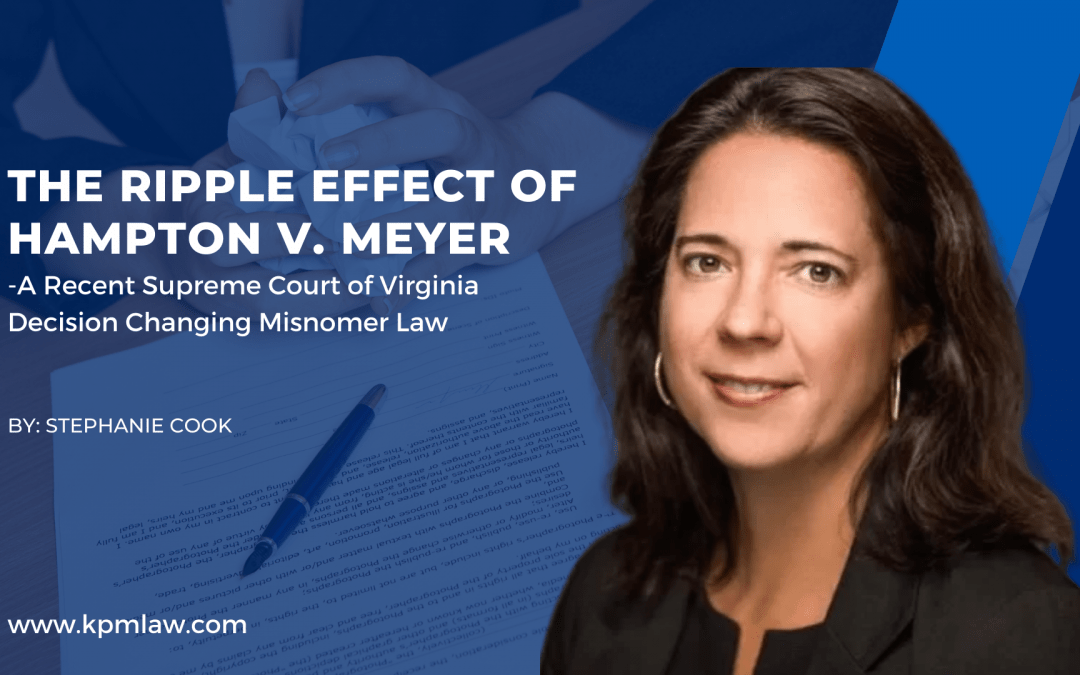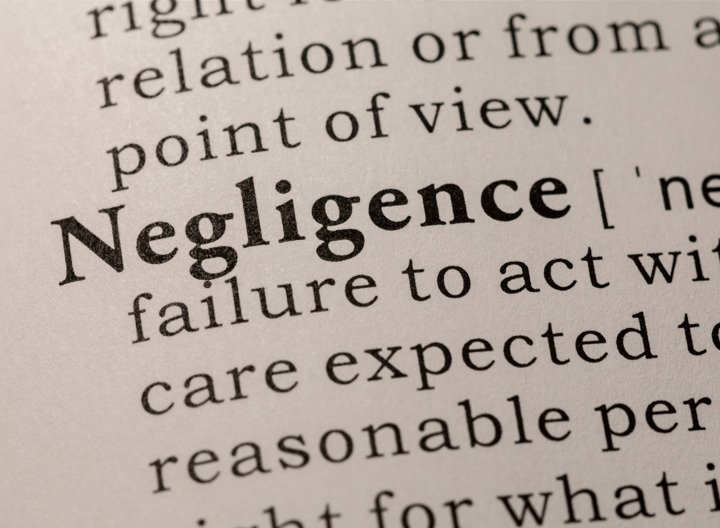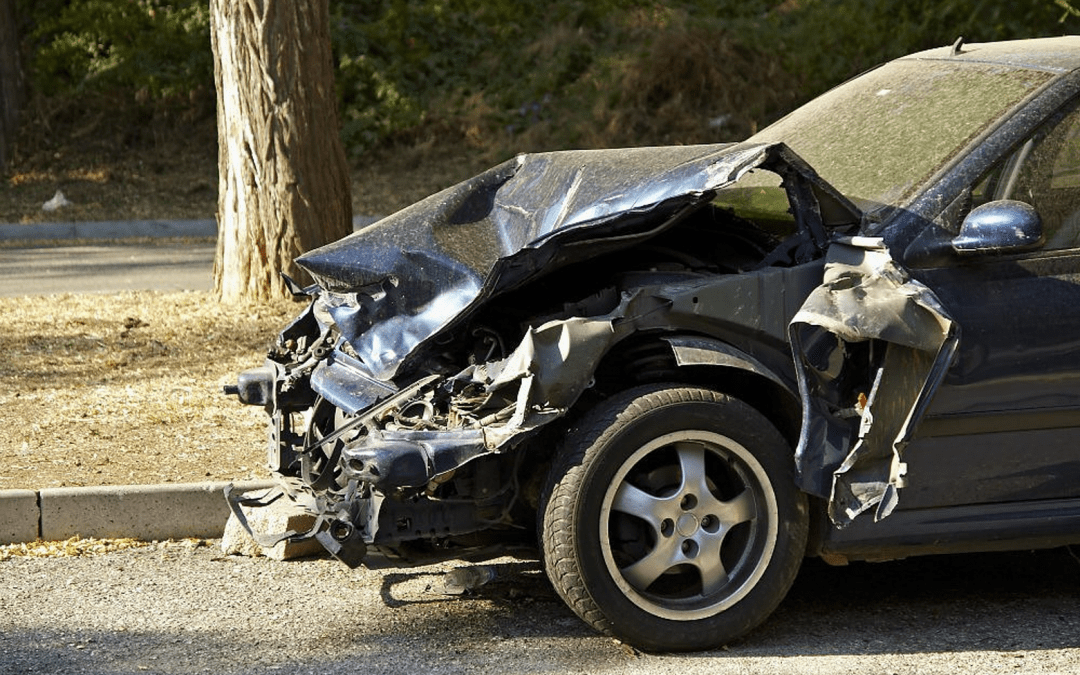
by KPM LAW | Jun 12, 2022 | Uncategorized
Written by Stephanie Cook, Esq. Edited by Bill Pfund, Esq. A somewhat recent decision by the Supreme Court of Virginia has turned the definition of a misnomer upside down and created quite a wave of plaintiffs attempting to save their cause of action by having their mistake of naming the wrong defendant declared a misnomer. In Hampton v. Meyer, 299 Va. 121 (August 2020), the Supreme Court of Virginia held that the incorrect naming of a defendant in a complaint may be considered a misnomer if the true party to the suit is sufficiently identified in the body of the complaint. The entire complaint as a whole must be considered in examining whether there is a misnomer. Whether a party named in a caption is a proper party to the action is to be determined not merely by how that party is identified in the caption of the pleading, but by the allegations set forth within a pleading that identify that party more specifically. A misnomer has historically been defined as a mistake in the name, not the identification of a party. Rockwell v. Allman, 211 Va. 560, 561 (1971). A misnomer occurs where the proper party has been identified but incorrectly named. Swann v. Marks, 252 Va. 181, 184 (1996). A misjoinder, on the other hand, is when the person or entity named in the pleading is not the person by or against whom the action could be or was intended to be brought. Estate of James v. Peyton, 277 Va. 443, 452 (2009). In Hampton v. Meyer, plaintiff intended to file suit against the driver who caused...

by KPM LAW | Sep 10, 2020 | KPMBlog, News, Profiles, Uncategorized
Written by Andrew Strobo Edited by Bill Pfund Negligence is deceivingly simple. To many people, negligence is something that they would know when they see it. Indeed, practically everyone intrinsically understands that to be negligent is to cause harm by failing to fulfill a duty owed. However, despite this simple definition, it can be surprisingly difficult to determine when a duty is owed under the law, what that duty is, and to whom it is owed. To make matters more complicated, Virginia law has undergone a number of relatively recent, significant changes which have made it more difficult than ever to answer these questions. This article will briefly discuss the general duty owed by all Virginians, two special circumstances in which an additional duty might be owed, and a recent, notable development under Virginia negligence law. Under Virginia law, each person has a general duty to exercise ordinary care to avoid injuring others as a consequence of his own actions. See Quisenberry v. Record No. 171494 Huntington Ingalls, Inc., 296 Va. 233, 243 (2018). Stated otherwise, the duty owed by a person is to mitigate the risks created by his own actions. For example, the driver of a vehicle creates a risk of harm to others by virtue of moving the vehicle, which can result in serious injury or death, and therefore has duty to take care in operating the vehicle, such as maintaining a reasonable speed. Accordingly, it is an important part of risk and liability analysis for every person to consider the reasonably foreseeable consequences of his own actions to understand the extent of his negligence liability....

by KPM LAW | Sep 9, 2020 | KPMBlog, News, Profiles, Uncategorized
Written by Daniel Royce, Esq. Edited by Bill Pfund, Esq. Let’s start with a thought exercise in the form of a hypothetical: A motor vehicle accident takes place in Virginia between a Virginia Claimant and an out of state tortfeasor. Assume for the sake of the hypothetical that liability is clear, and the claimed injuries are so significant as to exceed the liability limits and UM/UIM limits of the claimant. The tortfeasor is afforded coverage by a liability policy with limits of $10,000 per accident/$20,000 per occurrence. The claimant has UM/UIM coverage in the amount of $100,000 per accident/$300,000 per occurrence. In this hypothetical defense counsel represents the UM/UIM carrier. The liability carrier has tendered the $10,000 limits and plaintiff’s counsel is looking to the UM/UIM carrier for contribution to the settlement. The claimant has demanded the policy limits of $100,000. The questions presented are: whether the UM/UIM carrier is entitled to a credit/offset for the liability limits of $10,000? Is the UM/UIM carrier exposed in the amount of $90,000 or $100,000? Is this an uninsured or under-insured claim? In our hypothetical, Plaintiff’s counsel takes the position that the tortfeasor’s out of state policy does not “roll up” to the Virginia minimum limits of $25,000 and therefore the tortfeasor is deemed uninsured (and not under-insured)….but wait, I thought there were no minimum limits in Virginia?!?! Technically correct, Virginia drivers can pay a fee to the DMV for the privilege of driving without insurance on the highways and byways of this great state. (see Va. Code 46.2-706 below). If you are like me, your immediate answer to this question is “of...
by KPM LAW | Sep 7, 2020 | KPMBlog, News, Profiles, Uncategorized
Written by: Jessica Relyea Edited by: Brian A. Cafritz As we previously explained, Virginia allows for one nonsuit, or voluntary dismissal, by plaintiff per case. A nonsuit allows the plaintiff to correct a flaw in their case and reset the matter to the start in a future filing, with no real penalty or hardship. While it is a powerful tool at plaintiff’s discretion, it does not shield plaintiff from their own wrongdoing. This begs the question of what happens if plaintiff waits to nonsuit their case until after a defendant gets a favorable verdict in General District Court? Can plaintiff appeal and nonsuit, allowing it to refile in district court and obtain a new trial, essentially voiding the judgment? Can the defendant move to dismiss the refiled pleading on the grounds of res judicata because the first district court judgment is final? To understand this issue, a little background is important. In Virginia, the district court is a court of limited jurisdiction. The maximum recovery is $25,000, discovery is limited, and a judge decides all cases. Either party can appeal the judge’s verdict to the Circuit Court for a de novo jury trial. Importantly however, is that if there is a defense verdict in district court, then on appeal, plaintiff cannot increase his or her ad damnum and seek more than $25,000. Afify v. Simmons, 254 Va. 315, 317-318 (1997). If plaintiff nonsuits after an appeal to Circuit Court, but before the jury trial, where does the case get refiled? What rules apply when it does? This issue came before the Supreme Court in the 2011 case of Davis...




